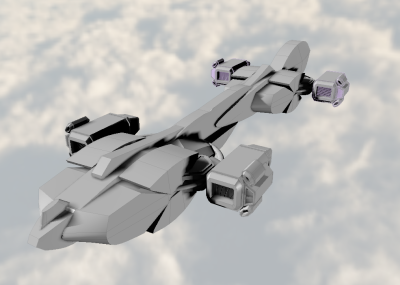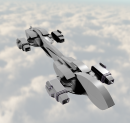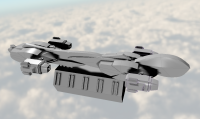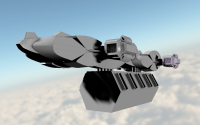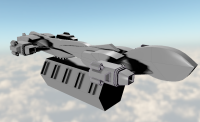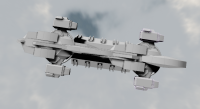Sidebar
Table of Contents
LM-TCR-SH-001 "Pti'tsae"
The Trans-Atmospheric Super Hauler designated LM-TCR-SH-001, commonly referred to as the Pti'tsae is a vessel designed to fill the need within the Lorath Matriarchy for a dedicated cargo hauling vessel capable of transporting a large quantity of goods using a robust, modular, easily repaired platform.
The Pti'tsae entered service in YE 37.
About the Pti'tsae
Composed primarily of rugged inexpensive parts the Pti'tsae is structurally comprised of several distinct components: A modified shuttle functioning as a command module; a durandium spine and frame housing the FTL and gravitic systems, backup generators, and spare fuel; four rugged self contained ram-jet fusion engines complete with internal fuel storage that feed power into the spine of the ship to power the FTL systems during normal operation; two sets of four large intakes affixed to the forward and rearward sections of the vessel used to replenish fuel stores in atmosphere as well as increase engine efficiency while entering or exiting a planet's atmosphere; and finally a large durandium cargo box that functions as the belly of the vessel.
This design results in a small inexpensive crew area literally comprised of a shuttle craft to function as crew quarters and the brain of the hauler. The rest of the ship is composed of a modular durandium body that ordinarily houses redundant heavy duty wiring allowing the various components of the large ship to communicate, share power, and provide the crew the means to control the four heavy fusion thrusters on the corners of the rectangular craft which preform the heavy lifting. This system also provides control to the ship's gravitic functions which are largely used to reduce the relative mass of the Pti'tsae allowing for more efficient power use.
A downside of this design is that while there are internal storage spaces for cargo, the main cargo box is largely outside of the control of the crew. It is intended instead to be dropped off and opened by workers on the ground who load or unload the box while the rest of the ship uncouples and moves on to collect a separate box to be moved.
An additional caveat of the design is the need to preform an EVA sortie to preform maintenance to the connections between the shuttle and the thrusters, or on the thrusters themselves should the need arise. However, as the ship has the capability to function with half of its engines operational the vessel is usually able to limp home without the need for the small crew to endanger themselves. Additionally repairs made by the crew are largely discouraged as damaged, or aging parts are intended to be swiftly detached and replaced by ground teams should any need arise. As well should the majority of the ship be crippled, the shuttle is capable of detaching in an emergency and functioning independently of the vessel.
The large durandium box is simple in construction generally only decorated by company markings. A quartet of relatively small 10m x 10m doors on either side allow loading and unloading of cargo, however for larger single piece items the back wall is able to open outward to function as a massive loading ramp. Built into the visually humble walls of the cargo box an array of gravitic systems have been installed for the purpose of mitigating the weight of the cargo box and its contents within.
Key Features
Primarily of note the crew portion of the craft is generally a lightly modified shuttle craft capable of detaching from the main body of the hauler after disconnecting from the control network for the purposes allowing it to be more easily repaired or to evacuate the crew in an emergency.
The quartet of engines are self contained units consisting of a large, rugged high-efficiency fusion reactor and a rugged high torque plasma thruster system. The primary purpose of the engine design is to allow one of the units to be removed as a whole and transported to a repair facility while a replacement unit is slotted into its place reducing the downtime of the entire craft as it is capable of quickly switching out damaged or worn components and resuming operation.
Continuing in the spirit of easily replaceable parts the main frame of the ship is distinct from the cargo box, attaching via heavy duty clamps (which are also replaceable) allowing the cargo box and the rest of the ship to separate in the event that one or the other requires maintenance.
Alternatively the clamps can be re-purposed to carry large military units or even piggyback disabled ships and move them.
A final feature is the availability of prefabricated modules that are easily installed within the interior of the cargo box allowing it to function as a refrigeration unit, evacuation vessel, or a temporary medical vessel.
Mission Specialization
- Cargo Transport
- Military Transport
- Evacuation
- Temporary Shelter Delivery
- Temporary Medical Ship
Appearance
Though the Pti'tsae is not intended to be a beautiful ship, the form being one of curving blocks and industrial pragmatism she is by no means an ugly vessel. At the fore of the ship nestled beneath a vane-like sensor block is a docked shuttle connected to the ship and hidden beneath a hood to protect the smaller craft.
Immediately noteworthy are four large intakes mounted on the frontal section of the vessel, two on the top, and two on the bottom that serve to supplement or replenish the ship's fuel needs. This construction is matched by an additional quartet on the rear half of the vessel. Branching off of the sides of the front and rear hull sections two arms extend terminating in the large blocky fusion engine and thruster modules attached to the arms by pivoting mounts.
Aside from the intakes and engines, the front and rear feature a pair of large areas where the hull has been expanded to provide room for extra fuel, internal storage, redundant systems, or any other equipment that may be desired. By default these sections are empty to save on weight.
The belly of the vessel's spine houses rugged mounting locks for affixing to a massive durandium cargo box, alternatively powerful freight clamps may be attached for when non-standard cargo, or other ships need to be moved. Finally the tail of the Pti'tsae is comprised of a large curved structure which houses the vessel's main sensor suite, back up generators, primary shielding, and secondary storage space.
History and Background
Created by the The New Tur'lista to fill the need for an inexpensive high volume cargo transport the Pti'tsae was conceptualized as a modular vessel to facilitate quick repair and upgrade cycles allowing users to keep their ships in circulation by minimizing time on the ground.
Initial development called for a rugged design with only the bare minimum to get it off of the ground, however it was quickly pointed out by engineers on the project that while functional the vessel had a number of inefficient qualities that needed addressing.
Foremost was the vessel's weight, at its size it proved too heavy to run purely on its engines alone, and while it proved capable of escape velocities it was hardly efficient. In order to circumvent this issue, extensive gravitational systems were installed allowing the vessel to modify its effective weight on the fly, allowing it to be almost feather weight when in atmosphere. This would allow the vessel to much more easily preform escape and re-entry manoeuvres and save exponentially on energy costs.
This adaptation led to the addition of secondary power sources and the large intakes allowing for further fuel efficiency and collection as needed. With these additions came increased internal space allowing specialized equipment or additional internal cargo space to be used further expanding the options of the design.
By the end defences to ward off pirate harassment were added as almost an afterthought leaving the Pti'tsae a relatively defenceless vessel by Lorath standards.
A final feature touched upon during development was the observation that the application of prefabricated modules to the cargo boxes generally fielded by the Pti'tsae, that the ship could fulfill a variety of purposes outside of pure cargo transport should the need arise.
Statistics and Performance
General
- Class: LM-TCR-SH-001
- Type: Super Hauler.
- Designers: Lorath Matriarchy New Tur'lista House
- Manufacturer: Lorath Shipyards, United Manufacturing Cooperative
- Fielded by: Lorath Self Defense Force, Lorath Matriarchy
Passengers
Crew: 2 operators are recommended, only 1 is required for operation. Of note the requirement for crew may be filled by an ARIA unit should it be desired by the operator of the vessel.
Maximum Capacity: There are accommodations for two people comfortably. About twelve people can fit aboard in an emergency, but the ship would be extremely cramped. Additionally the cargo boxes if properly prepared (filled with atmosphere and pressurized) can be utilized to transport four-thousand people in an emergency.
Dimensions
- Length: 1000 meters (3280.84 feet)
- Width: 350 meters (1148.29 feet)
- Height: 180 meters (590.551 feet)
- Decks: 3
Propulsion and Range
- Speed (STL): 0.2c
- Speed (FTL): 9500c
- Speed (Hyperspace Fold Drive): 0.2 ly/m
- Speed (Aerial): Mach .99 (761 mph) (1,224 Kph) (Sustained flight)
- Speed (Atmosphere Escape): 30,000mph (48,280 kph)
- Lifespan: 25 years; Indefinite with proper maintenance
- Refit Cycle: At least every two years, or as often as possible.
Damage Capacity
- Hull: 40 SP
- Shields: 20 SP (Threshold 2)
Inside the Ship
Compartment Layouts
Bridge
Situated at the front of the ship usually hidden behind a durandium cowl the bridge of the Pti'tsae unusually consists of a modified Journey-Class Shuttle designed to interface with the rest of the vessel. Further differentiating it from traditional design the bridge doubles as the crew quarters providing living space for the occupants.
Cargo Storage Areas
The main cargo storage area of the Pti'tsae consists of a large 650m x250m x 250m cargo box that can hold up to 600 SSCC-Huge Cargo containers. This is usually held by mounting clamps on the belly of the vessel's spine.
Additionally the vessel sports four large 200m x 150m x 120m storage areas, two on the front of the vessel, and two on the back.
A final 200m x 80m x 100m space rests in the tail of the vessel.
Engineering
Engineering consists of access to the primary engines, FTL systems, and sensors via a passage running the length of the vessel's spine lined with conduits and pipes used to transmit energy and fuel between the sections of the ship. Branching off from the main section are several smaller passages allowing access to the conduits that run the length of the ship as well as allowing access to the internal storage sections.
Ship Systems
Armored Hull and Hull Integrated Systems
Frame
The frame of the Pti'tsae has been designed Durandium with Duremium Alloy secondary supports and along critical areas in denser portions to ensure an overall well built, and sturdy frame work.
Armor System
Durandium Alloy Primary Hull Plate
The primary hull structure of the Pti'tsae which comprises the fuselage, pylons, and other primary exterior components is comprised of Durandium. This layer serves as the primary structure and support layer, along with providing a robust defence against weapons fire. The outer hull is designed to mount onto the internal frame in a manner that allows rapid removal and replacement in the event of damage.
Power Systems
The Pti'tsae's primary power supply is generated by the excess energy generated by its main Fusion Engines, however if needed they can be re-purposed into functioning as dedicated fusion generators at the cost of mobility. Additionally along the spine of the Pti'tsae are six secondary fusion generators which are primarily used to provide supplementary power to the ship and to help power the vessel's FTL systems. During normal operation only two secondary generators are usually in operation the others remaining on standby should additional power requirements need to be met or to function as replacements in the case of component failure.
Propulsion
Equipped with four massive pylon mounted modernized fusion thrusters, each mated with a pair of smaller secondary ram-jet boosters mounted to the outside of each engine assembly the Pti'tsae is able to generate huge amounts of thrust allowing it to lift its fully loaded hull even without the use of the in built gravitic systems. Secondary propulsion is available in the form of the Pti'tsae's gravitic systems, however these are largely inefficient and would tax the systems which are normally only used to reduce the weight of the vessel.
For the purposes of FTL travel the Pti'tsae is equipped with an Enhanced Lorath Subspace System as well as a weak, but functional hyperspace fold drive.
Gravity Manipulation
Throughout the vessel are located dozens of redundant lobotomized Unified Manipulation Technology Suites utilized to negate the Pti'tsae's impressive mass allowing for more rapid and fuel efficient escape from planetary bodies, as well as reducing the stress upon re-entry. These systems are capable of providing artificial gravity throughout the vessel, though this functionality is not intended.
Computers and Electronics
By default the Pti'tsae comes equipped with a Lorath computing suite accessible throughout the ship by a civilian grade version of the LSDF Minor Computer Access. Should it be desired the vessel may additionally be augmented by redundant systems or one or more ARIA Ship Control Systems as deemed necessary.
Communications
By default the vessel is only outfitted with common Lorath communications functionality.
Sensors
The Pti'tsae is normally outfitted with a suite of common Lorath sensors allowing the vessel a fair degree of awareness of its surroundings.
Emergency Systems
The ship is equipped with a plasma bath system capable of scouring all of the passages and cargo sections in the event of unwanted boarders or vermin. As well should the vessel need to be evacuated the bridge section can detach and function as a modified Journey-Class Shuttle equipped with a subspace radio and minor medical supplies.
Life Support Systems
The vessel normally only has limited life support systems with only the shuttle functioning as the bridge being pressurized and containing breathable atmosphere. The rest of the ship normally remains devoid of hospitable conditions, however if needed the vessel can be filled with atmosphere.
Shield Systems
Full Spectrum Barrier System
The Pti'tsae uses Lorath Shielding Systems allowing it to employ:
- Electromagnetic Shielding
- Plasma Shielding
- Gravitational Shielding
Psionic Protection
The Pti'tsae includes a Psionics Scrambler Device to protect itself against the possibility of psionic assault.
Defensive Weapons
Plasma-Arc Disruptor Strips
The Pti'tsae includes hundreds of Plasma Arc Vent Strips which are placed every ten meters to provide 360 coverage and are intended to prevent missile impacts or power armor assaults.
Optional External Turrets
The Pti'tsae also has external ports which allow for up to forty twin-mounted Compressed Packet Rifle turrets to be externally mounted and controlled from the pilot module of the Pti'tsae.
OOC
Created 2015/06/23 12:29 by Eistheid Approved 2015/09/12 19:05
Page Tools
Terms of Service - Privacy Policy

